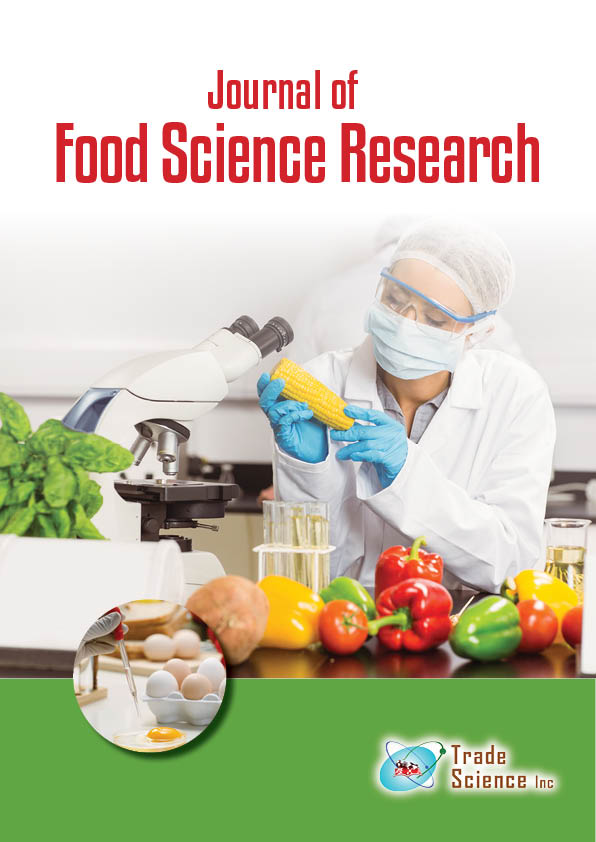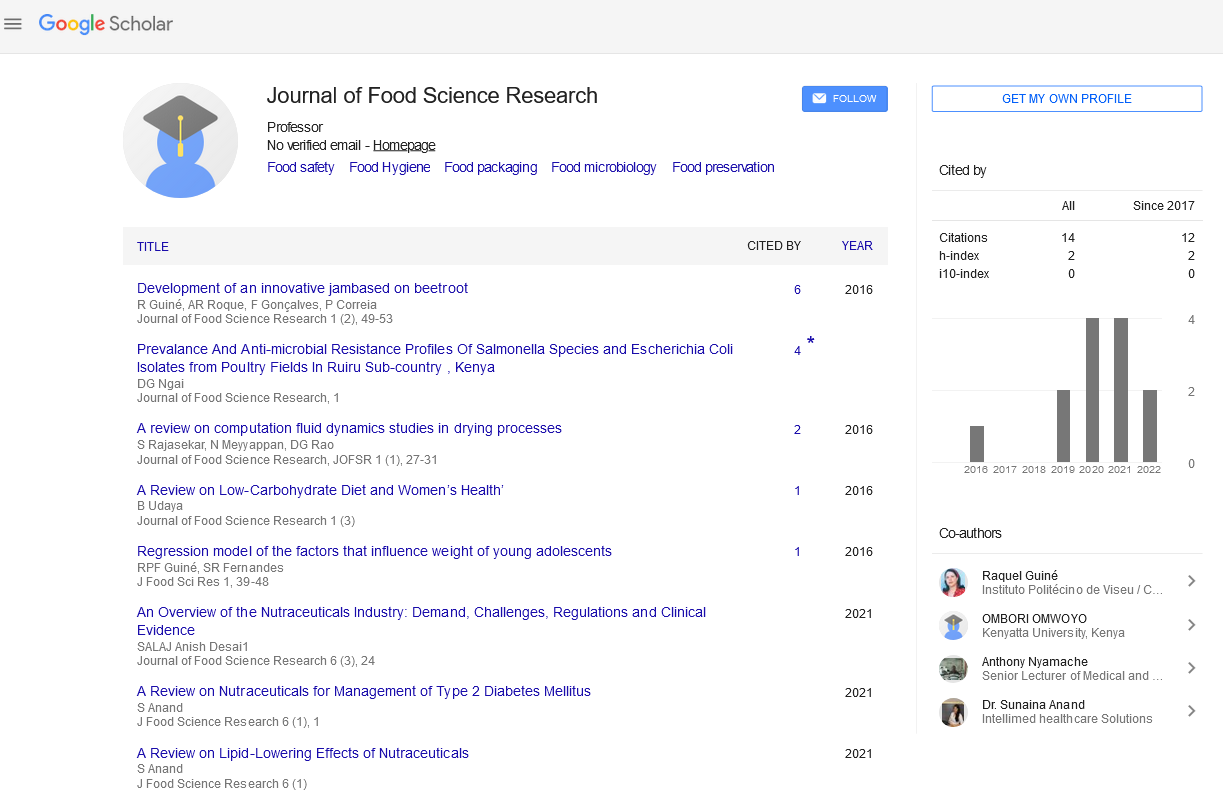Short communication
, Volume: 6( 6)
The physiological effects of post-harvest banana diseases
Banana trees belong to the Musa genus and are enormous perennial herbs native to Southeast Asia. The Musa genus is
separated into two segments from a botanical standpoint: edible and wild species. All consummated bananas have wild
diploid and seminifar non edible parents, notably Musa acuminate (AA) and Musa balbisiana (BB). Seedless triploid
clones produce the majority of bananas consumed. There are three types of edible bananas. First, there are ?dessert?
bananas (AAA), which have a high sugar content. It includes the Cavendish, Gros-Michel, and Figue-rose sub-groups,
as well as the majority of cultivated bananas. These are usually types intended for export. Their manufacturing process
necessitates a large number of inputs and is based on a mono specific
model with no rotation. Second, at maturity,
cooking bananas (AAB) have a high carbohydrate content. Plantain bananas make up the majority of this group. Third,
the ABB triploid group is represented by more hardy bananas, the fruits of which must be cooked before consumption.
Bananas are grown in tropical and subtropical climates in more than 120 nations across five continents. After rice,
wheat, and maize, banana output is the world?s fourth largest in terms of tonnage. Global production in 2013 was anticipated to be around 106 million tonnes, including 2 million tonnes produced in the Caribbean. Only a small portion,
however, is generated for commercial uses. Self-sufficiency is scheduled for at least 85 % of the population. It?s all
about cooking bananas here. The dessert banana, on the other hand, is typically grown for export. Bananas produced
in gardens provide a reasonable income in many underdeveloped nations.
Bananas and plantains meet at least 25% of the energetic demands of underdeveloped countries from a nutritional
standpoint. Its pulp is high in sugars that are easily digested. Bananas are made up of roughly 70% water, 27% carbohydrates, 1.2% protein, and 0.3% fatty acids chemically.
Banana farming has a number of threats, such as diseases and pests, that must be considered in order to optimise
banana production. We can cite, for example, Mycosphaerellafijiensis-caused black leaf streak disease and Mycosphaerellamusicola-caused Sigatoka disease, as well as
Fusarium wilt. Bacterial and viral agents such as Moko disease,
BBTV (Banana Bunchy Top Virus), CMV (Cucumber Mosaic Virus), BSV (Banana Streak Virus), or BBMV (Banana
Bunchy Top Virus) cause further limitations (Banana Bract Mosaic Virus). Finally, insects such as the black weevil and
nematodes are a source of concern. Currently, the majority of control measures are chemical. Unfortunately, because
to their high cost, these are not available to small banana producers in developing nations, and they have a detrimental
environmental impact.
Furthermore, chemical control is not always effective due to the emergence of resistant strains or a lack of effective
molecules against some diseases. As a result, genetic improvement projects are needed to produce resistant types to
the most common pests and diseases. These initiatives, particularly for export bananas, have taken into account some
socio-economic aspects of production. In this regard, new hybrids must meet all agronomic, functional, and sensory
requirements.
Banana genetic development is required to redirect parasitic pressure from banana production, as well as to respond to
customer demand for better traceability and the perceived harmful impacts of pesticides on the environment. Similarly,
small farmers may not always be able to afford farm inputs, and novel hybrids may be able to address one of the century?s most pressing issues: food security. The development of abiotic and biotic
stress resistant variants is the primary
goal of genetic improvement. The second goal is to develop novel, appealing, and segmenting types, particularly for
Corresponding Author: Shunxin Gary, Department of Food Science, Sun Moon University, Tangjeong-myeon,
Asan-si, Korea, E-mail: shunxingary@sunmoon.ac.kr
Received date: November 08, 2021; Accepted date: November 22, 2021; Published date: November 30, 2021
www.tsijournals.com
the export market.
The current problem in genetic enhancement is to collect as many criteria as possible to aid in decision-making during
the selection phase. Breeders must simply choose hybrids that will likely match the requirements of operators and
consumers. Optimal quality is required throughout the whole post-harvest process, which includes banana storage,
transportation, ripening, and marketing. There are two sorts of quality that must be met: functional and sensory. Physiological problems and vulnerability to post-harvest illnesses were among the functional attributes. More consumers?
expectations in terms of the end product are reflected in sensory quality.
Conclusion
Physiological problems make it difficult for banana growers to acquire new types. In contrast to Cavendish bananas,
post-harvest quality and production at harvest are not guaranteed for these types. However, a paradigm shift is essential
because the existing mono specialised approach relying solely on external inputs is unsustainable. Growing new kinds
with more environmentally friendly approaches will demand changes and adaptations from all banana stakeholders.
Physiological disorders, on the other hand, have solutions. Their application does not necessarily necessitate complex
technicalities. These issues can be solved to some extent by using the right maturity stage at harvest, a polyethylene
bag, and adjusting the temperature and relative humidity of the air ambient from harvest to ripening stage and market.
Abstract
Banana trees belong to the Musa genus and are enormous perennial herbs native to Southeast Asia. The Musa genus is
separated into two segments from a botanical standpoint: edible and wild species. All consummated bananas have wild
diploid and seminifar non edible parents, notably Musa acuminate (AA) and Musa balbisiana (BB). Seedless triploid
clones produce the majority of bananas consumed. There are three types of edible bananas. First, there are â??dessertâ?
bananas (AAA), which have a high sugar content. It includes the Cavendish, Gros-Michel, and Figue-rose sub-groups,
as well as the majority of cultivated bananas. These are usually types intended for export. Their manufacturing process
necessitates a large number of inputs and is based on a mono specific
model with no rotation. Second, at maturity,
cooking bananas (AAB) have a high carbohydrate content. Plantain bananas make up the majority of this group. Third,
the ABB triploid group is represented by more hardy bananas, the fruits of which must be cooked before consumption.
Bananas are grown in tropical and subtropical climates in more than 120 nations across five continents. After rice,
wheat, and maize, banana output is the worldâ??s fourth largest in terms of tonnage. Global production in 2013 was anticipated to be around 106 million tonnes, including 2 million tonnes produced in the Caribbean. Only a small portion,
however, is generated for commercial uses. Self-sufficiency is scheduled for at least 85 % of the population. Itâ??s all
about cooking bananas here. The dessert banana, on the other hand, is typically grown for export. Bananas produced
in gardens provide a reasonable income in many underdeveloped nations.

